
© Mercury Systems, Inc. THIRD QUARTER FISCAL YEAR 2024 FINANCIAL RESULTS Bill Ballhaus Chairman and CEO David Farnsworth Executive Vice President and CFO May 7, 2024, 5:00 pm ET Webcast login at www.mrcy.com/investor Webcast replay available by 7:00 p.m. ET May 7, 2024

© Mercury Systems, Inc.2 Does not contain Technical Data. //Mercury Proprietary/No Tech Data// Forward-looking safe harbor statement This presentation contains certain forward-looking statements, as that term is defined in the Private Securities Litigation Reform Act of 1995, including those relating to the Company's focus on enhanced execution of the Company's strategic plan under a refreshed Board and leadership team. You can identify these statements by the words “may,” “will,” “could,” “should,” “would,” “plans,” “expects,” “anticipates,” “continue,” “estimate,” “project,” “intend,” “likely,” “forecast,” “probable,” “potential,” and similar expressions. These forward-looking statements involve risks and uncertainties that could cause actual results to differ materially from those projected or anticipated. Such risks and uncertainties include, but are not limited to, continued funding of defense programs, the timing and amounts of such funding, general economic and business conditions, including unforeseen weakness in the Company’s markets, effects of any U.S. federal government shutdown or extended continuing resolution, effects of geopolitical unrest and regional conflicts, competition, changes in technology and methods of marketing, delays in or cost increases related to completing development, engineering and manufacturing programs, changes in customer order patterns, changes in product mix, continued success in technological advances and delivering technological innovations, changes in, or in the U.S. government’s interpretation of, federal export control or procurement rules and regulations, changes in, or in the interpretation or enforcement of, environmental rules and regulations, market acceptance of the Company's products, shortages in or delays in receiving components, supply chain delays or volatility for critical components such as semiconductors, production delays or unanticipated expenses including due to quality issues or manufacturing execution issues, capacity underutilization, increases in scrap or inventory write-offs, failure to achieve or maintain manufacturing quality certifications, such as AS9100, the impact of supply chain disruption, inflation and labor shortages, among other things, on program execution and the resulting effect on customer satisfaction, inability to fully realize the expected benefits from acquisitions, restructurings, and operational efficiency initiatives or delays in realizing such benefits, challenges in integrating acquired businesses and achieving anticipated synergies, effects of shareholder activism, increases in interest rates, changes to industrial security and cyber-security regulations and requirements and impacts from any cyber or insider threat events, changes in tax rates or tax regulations, such as the deductibility of internal research and development, changes to interest rate swaps or other cash flow hedging arrangements, changes to generally accepted accounting principles, difficulties in retaining key employees and customers, litigation, including the dispute arising with the former CEO over his resignation, unanticipated costs under fixed-price service and system integration engagements, and various other factors beyond our control. These risks and uncertainties also include such additional risk factors as are discussed in the Company's filings with the U.S. Securities and Exchange Commission, including its Annual Report on Form 10-K for the fiscal year ended June 30, 2023 and subsequent Quarterly Reports on Form 10-Q and Current Reports on Form 8-K. The Company cautions readers not to place undue reliance upon any such forward-looking statements, which speak only as of the date made. The Company undertakes no obligation to update any forward-looking statement to reflect events or circumstances after the date on which such statement is made. Use of Non-GAAP (Generally Accepted Accounting Principles) Financial Measures In addition to reporting financial results in accordance with generally accepted accounting principles, or GAAP, the Company provides adjusted EBITDA, adjusted income, adjusted EPS, free cash flow, organic revenue and acquired revenue, which are non-GAAP financial measures. Adjusted EBITDA, adjusted income, and adjusted EPS exclude certain non-cash and other specified charges. The Company believes these non-GAAP financial measures are useful to help investors better understand its past financial performance and prospects for the future. However, these non-GAAP measures should not be considered in isolation or as a substitute for financial information provided in accordance with GAAP. Management believes these non-GAAP measures assist in providing a more complete understanding of the Company’s underlying operational results and trends, and management uses these measures along with the corresponding GAAP financial measures to manage the Company’s business, to evaluate its performance compared to prior periods and the marketplace, and to establish operational goals. A reconciliation of GAAP to non-GAAP financial results discussed in this presentation is contained in the Appendix hereto.
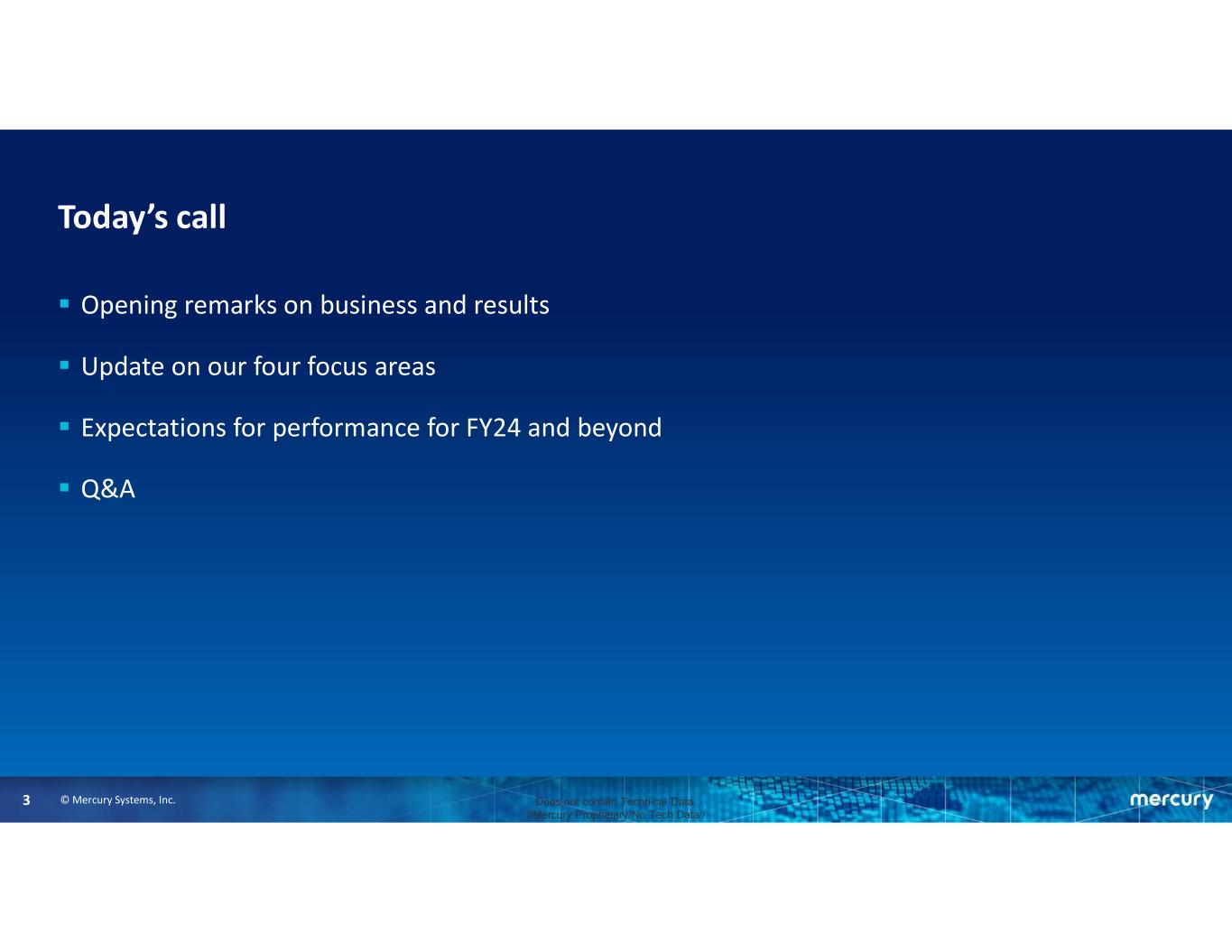
© Mercury Systems, Inc.3 Does not contain Technical Data. //Mercury Proprietary/No Tech Data// Today’s call Opening remarks on business and results Update on our four focus areas Expectations for performance for FY24 and beyond Q&A

© Mercury Systems, Inc.4 Does not contain Technical Data. //Mercury Proprietary/No Tech Data// Business and results Optimistic about our strategic positioning, business model, and outlook. Q2 election to pause transition of Common Processing Architecture to full-rate production impacted results, as expected. Significant advancements resolving Common Processing Architecture technical production challenges; now progressing toward full-rate production. Challenges that we believe to be transitory persist while we continue to make progress on our four priority focus areas. Continued progress on challenged programs, backlog growth, and reduction in working capital. We believe FY24 is a transition year and look forward to entering FY25 with a clear path to predictable, profitable organic growth with strong free cash flow.

© Mercury Systems, Inc.5 Does not contain Technical Data. //Mercury Proprietary/No Tech Data// Enhancing execution to deliver predictable performance Working to mitigate impact of select items on revenue and pre-tax earnings $16 $39 $12 $5 $6 EAC Cost Growth Inventory Reserves & Scrap Warranty Reserves Contract Matters Total (1) (2) (3) (4) (1) EAC cost growth is a negative adjustment to revenue that represents a reduction in gross margin and other GAAP and non-GAAP earnings including loss before income taxes benefit, and adjusted EBITDA. (2) Represents inventory reserves & scrap activity in quarter above the FY23 quarterly average balance. Represents a reduction in gross margin and other GAAP and non-GAAP earnings including loss before income taxes benefit and adjusted EBITDA. (3) Represents warranty reserve expense for the potential repair and rework of some previously delivered common processing architecture products. Represents a reduction in gross margin and other GAAP and non-GAAP earnings including loss before income taxes benefit and adjusted EBITDA. (4) Represents contract settlement reserves associated with such potential settlements in quarter. Represents an increase to SG&A expense in quarter. Majority of select items isolated to ~20% of business, resulting in negative gross margin contribution and obscuring performance in the majority of the business
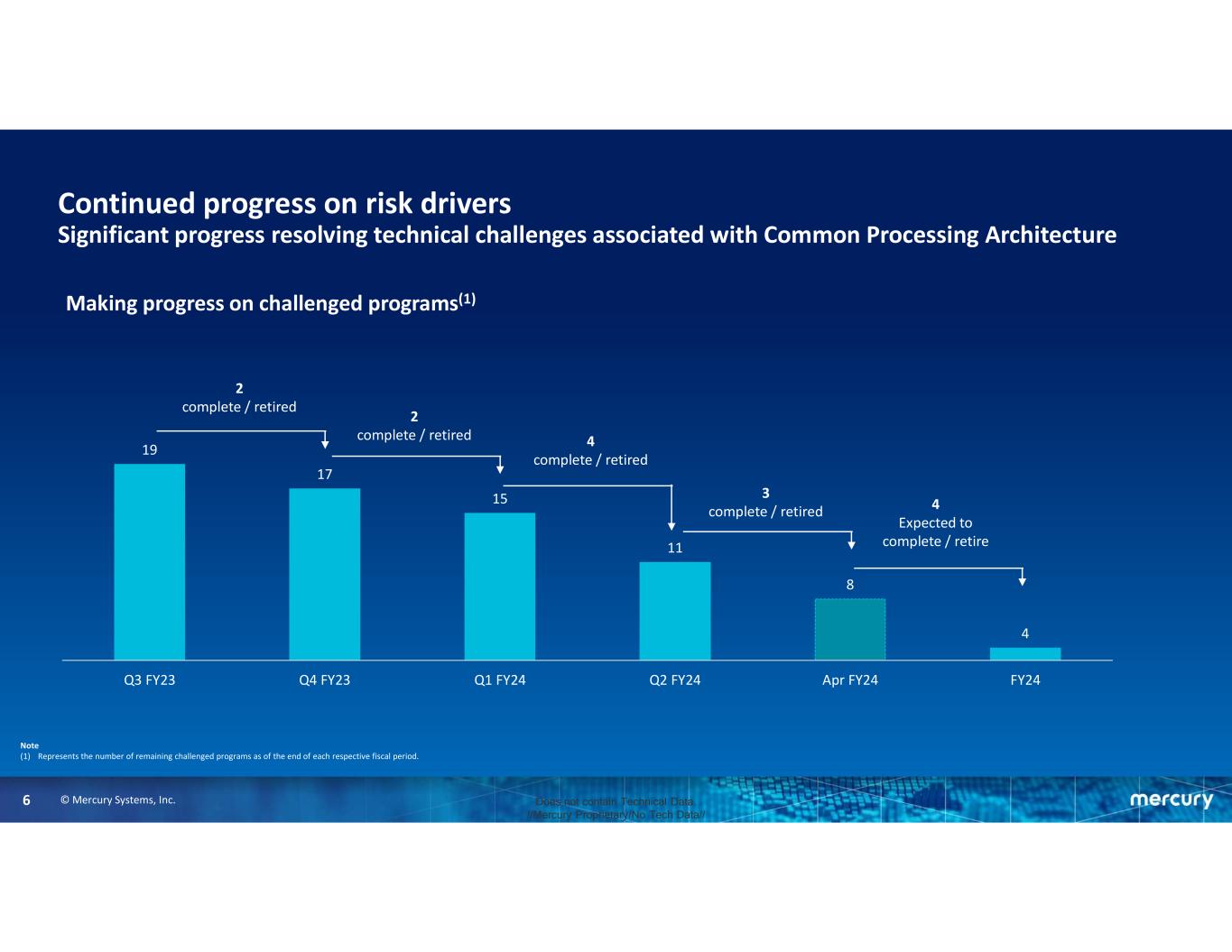
© Mercury Systems, Inc.6 Does not contain Technical Data. //Mercury Proprietary/No Tech Data// Continued progress on risk drivers Significant progress resolving technical challenges associated with Common Processing Architecture 19 17 15 11 8 4 Q3 FY23 Q4 FY23 Q1 FY24 Q2 FY24 Apr FY24 FY24 Note (1) Represents the number of remaining challenged programs as of the end of each respective fiscal period. Making progress on challenged programs(1) 2 complete / retired 2 complete / retired 4 complete / retired 3 complete / retired 4 Expected to complete / retire
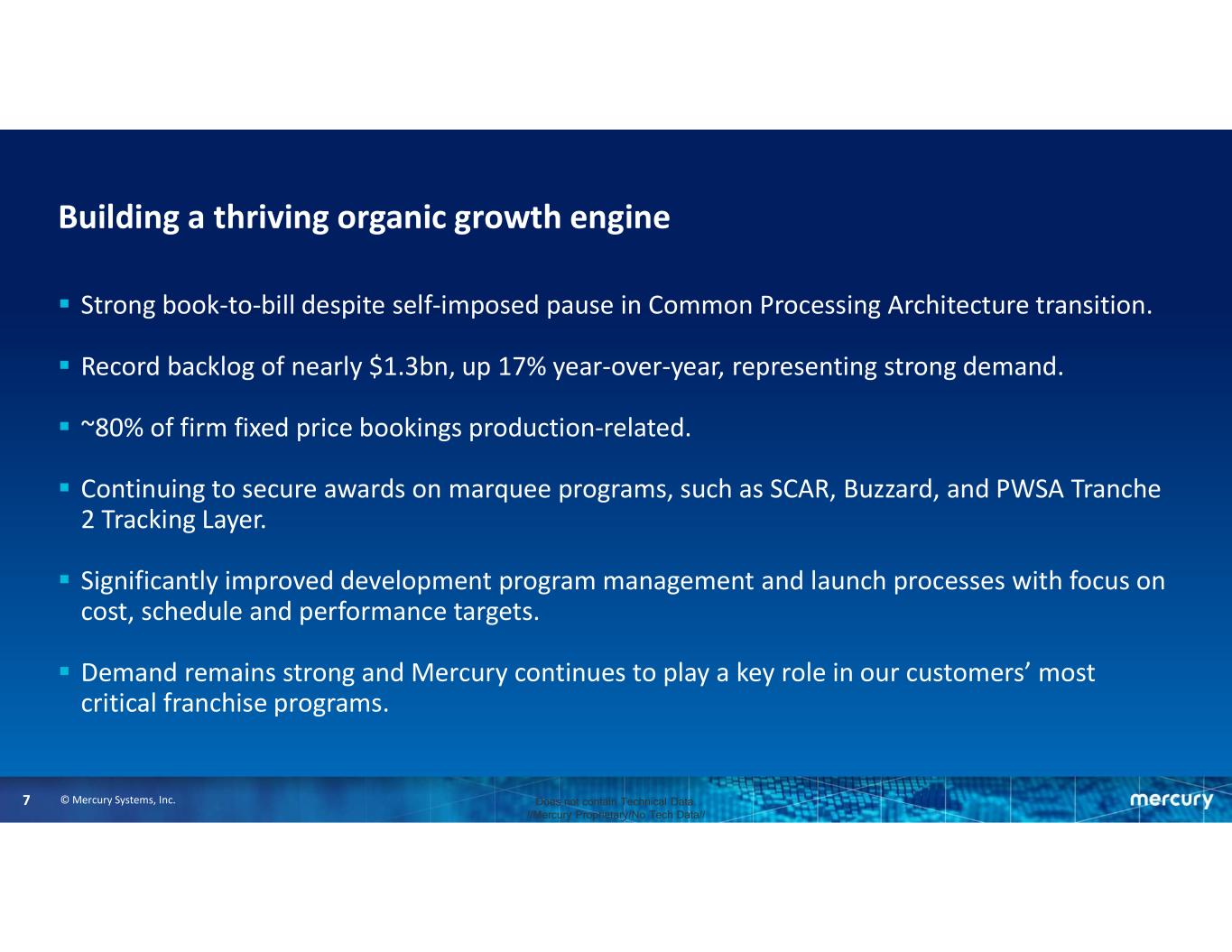
© Mercury Systems, Inc.7 Does not contain Technical Data. //Mercury Proprietary/No Tech Data// Building a thriving organic growth engine Strong book-to-bill despite self-imposed pause in Common Processing Architecture transition. Record backlog of nearly $1.3bn, up 17% year-over-year, representing strong demand. ~80% of firm fixed price bookings production-related. Continuing to secure awards on marquee programs, such as SCAR, Buzzard, and PWSA Tranche 2 Tracking Layer. Significantly improved development program management and launch processes with focus on cost, schedule and performance targets. Demand remains strong and Mercury continues to play a key role in our customers’ most critical franchise programs.

© Mercury Systems, Inc.8 Does not contain Technical Data. //Mercury Proprietary/No Tech Data// Addressing our cost structure to expand margins Margins impacted by what we believe to be transitory items and negative operating leverage. Focused development program execution and mix shift to production. Cost rationalization efforts of $44 million to date, of which $24-$26 million expected in FY24, with upside from recent organizational changes. Moving to product / solution structure to optimize investment and go-to-market posture. Recent organizational alignment expected to drive additional savings and accelerate operating leverage.
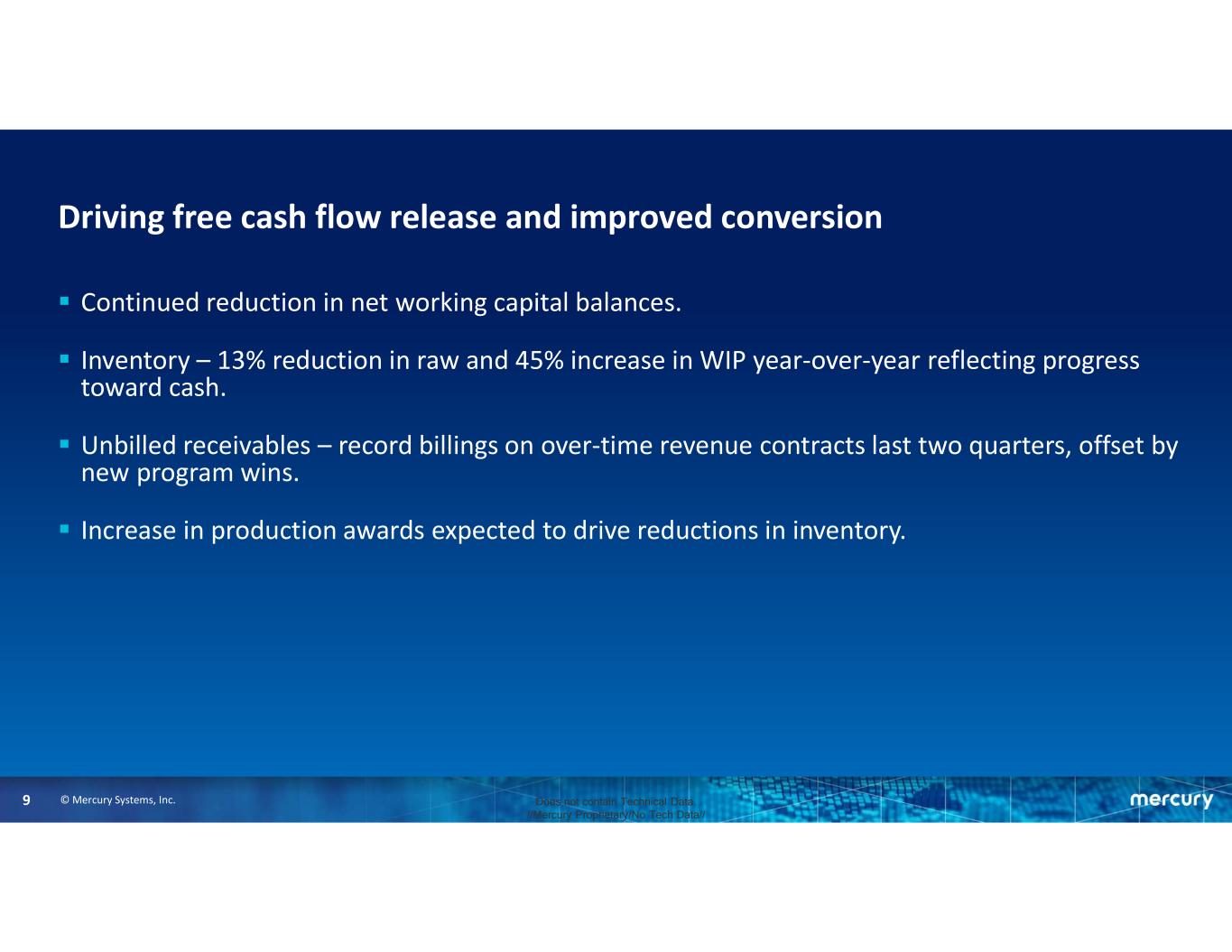
© Mercury Systems, Inc.9 Does not contain Technical Data. //Mercury Proprietary/No Tech Data// Driving free cash flow release and improved conversion Continued reduction in net working capital balances. Inventory – 13% reduction in raw and 45% increase in WIP year-over-year reflecting progress toward cash. Unbilled receivables – record billings on over-time revenue contracts last two quarters, offset by new program wins. Increase in production awards expected to drive reductions in inventory.

© Mercury Systems, Inc.10 Does not contain Technical Data. //Mercury Proprietary/No Tech Data// Expectations for FY24 and beyond Continue to target above-average industry growth, mid-20 percent adjusted EBITDA margins. Maintaining focus on transitioning development programs to production, especially our common processing architecture, and releasing net working capital. Demand remains strong, continue to expect FY24 bookings to exceed $1 billion. Continue to expect $800 million to $850 million in FY24 revenue. Outlook for positive full fiscal year free cash flow remains unchanged. Focused on entering FY25 with a clear path to organic growth, expanding margins, and strong free cash flow.

© Mercury Systems, Inc.11 Does not contain Technical Data. //Mercury Proprietary/No Tech Data// Q3 FY24 vs. Q3 FY23 CHANGEQ3 FY23(2)Q3 FY24(2)In $ millions, except percentage and per share data (10%)$245.0 0.93 $219.9 1.06 Bookings Book-to-Bill 17%$1,099.2 695.0 $1,289.8 761.2 Backlog 12-Month Backlog (21%)$263.5$208.3Revenue (1,480) bps34.3%19.5%Gross Margin (2%) $88.3 44.6 26.5 17.2 $86.3 43.2 21.6 21.5 Operating Expenses Selling, General & Administrative Research & Development Amortization/Restructuring/Acquisition N.A.$5.2($44.6)GAAP Net (Loss) Income N.A.$0.09 56.9 ($0.77) 57.7 GAAP (Loss) Earnings Per Share Weighted Average Diluted Shares N.A.$0.40($0.26)Adjusted EPS(1) N.A.$43.5 15.5% ($2.4) N.A. Adj. EBITDA(1) % of revenue N.A.($3.2)($17.8)Operating Cash Flow N.A.($12.7) N.A. ($25.7) N.A. Free Cash Flow(1) % of Adjusted EBITDA Notes (1) Non-GAAP, see reconciliation table. (2) All references in this presentation to the third quarter of fiscal 2024 are to the quarter ended March 29, 2024 . All references to the third quarter of fiscal 2023 are to the quarter ended March 31, 2023.

© Mercury Systems, Inc.12 Does not contain Technical Data. //Mercury Proprietary/No Tech Data// Balance sheet As of 3/29/2412/29/239/29/236/30/233/31/23(In $ millions)(1) ASSETS $142.6$168.6$89.4$71.6$64.4Cash & cash equivalents 417.2433.7480.0507.3502.3Accounts receivable, net 343.0354.2363.0337.2342.8Inventory, net 113.9114.4117.2119.6119.5PP&E, net 1,199.91,211.41,223.61,236.11,248.7Goodwill and intangibles, net 161.6154.0127.6119.6106.2Other $2,378.1$2,436.3$2,400.8$2,391.4$2,383.9TOTAL ASSETS LIABILITIES AND S/E $136.9$144.7$147.2$162.8$170.4AP and accrued expenses 151.9170.6136.3150.4141.1Other liabilities 616.5616.5576.5511.5511.5Debt 905.3931.8860.0824.7823.0Total liabilities 1,472.81,504.51,540.81,566.71,560.9Stockholders’ equity $2,378.1$2,436.3$2,400.8$2,391.4$2,383.9TOTAL LIABILITIES AND S/E Notes (1) Rounded amounts used.
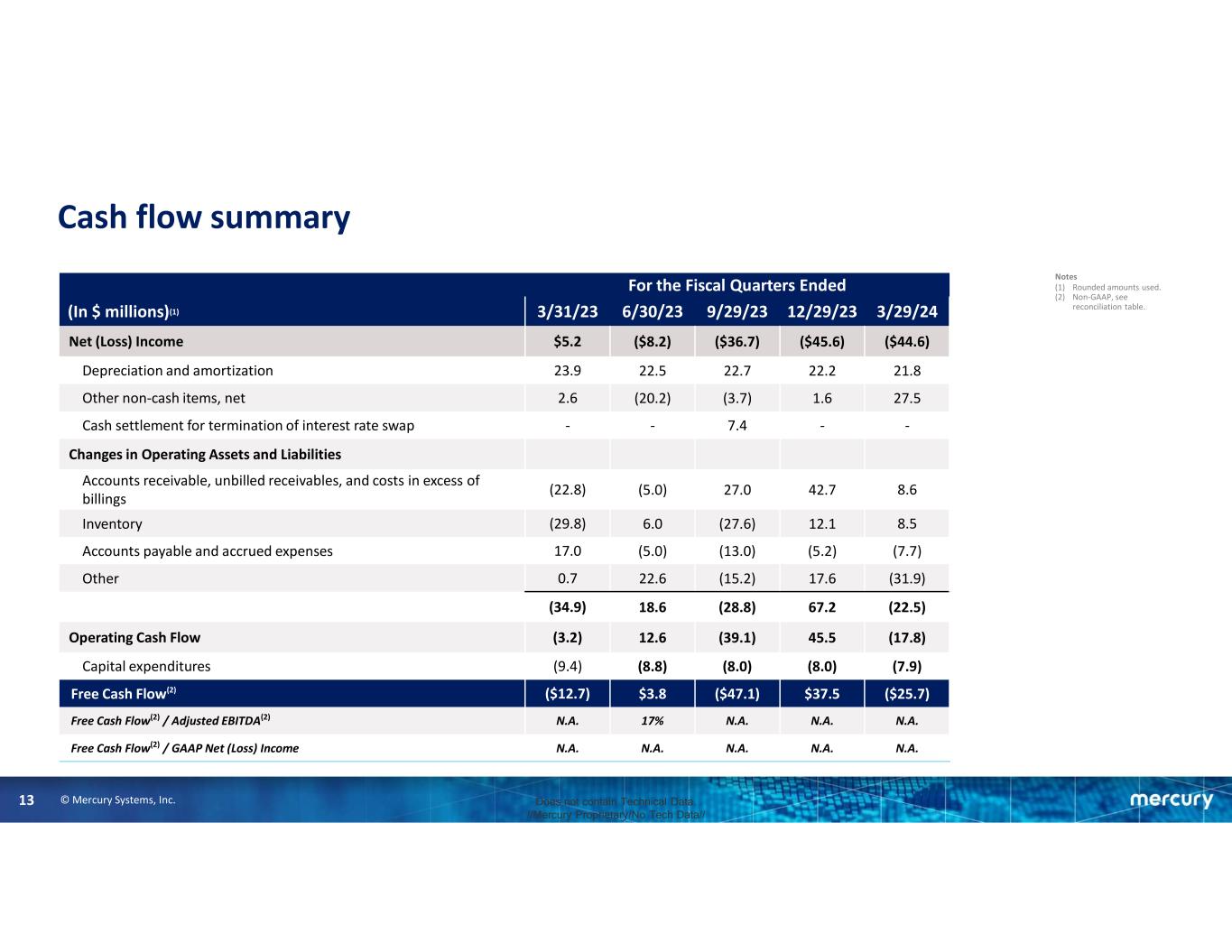
© Mercury Systems, Inc.13 Does not contain Technical Data. //Mercury Proprietary/No Tech Data// Cash flow summary For the Fiscal Quarters Ended 3/29/2412/29/239/29/236/30/233/31/23(In $ millions)(1) ($44.6)($45.6)($36.7)($8.2)$5.2Net (Loss) Income 21.822.222.722.523.9Depreciation and amortization 27.51.6(3.7)(20.2)2.6Other non-cash items, net --7.4--Cash settlement for termination of interest rate swap Changes in Operating Assets and Liabilities 8.642.727.0(5.0)(22.8)Accounts receivable, unbilled receivables, and costs in excess of billings 8.512.1(27.6)6.0(29.8)Inventory (7.7)(5.2)(13.0)(5.0)17.0Accounts payable and accrued expenses (31.9)17.6(15.2)22.60.7Other (22.5)67.2(28.8)18.6(34.9) (17.8)45.5(39.1)12.6(3.2)Operating Cash Flow (7.9)(8.0)(8.0)(8.8)(9.4)Capital expenditures ($25.7)$37.5($47.1)$3.8($12.7)Free Cash Flow(2) N.A.N.A.N.A.17%N.A.Free Cash Flow(2) / Adjusted EBITDA(2) N.A.N.A.N.A.N.A.N.A.Free Cash Flow(2) / GAAP Net (Loss) Income Notes (1) Rounded amounts used. (2) Non-GAAP, see reconciliation table.

14 APPENDIX

© Mercury Systems, Inc.15 Does not contain Technical Data. //Mercury Proprietary/No Tech Data// Adjusted EPS reconciliation Notes (1) Per share information is presented on a fully diluted basis. (2) Rounded amounts used. (3) Impact to income taxes is calculated by recasting income before income taxes to include the items involved in determining adjusted income and recalculating the income tax provision using this adjusted income from operations before income taxes. The recalculation also adjusts for any discrete tax expense or benefit related to the items. (4) All references in this presentation to the third quarter of fiscal 2024 and LTM Q3 FY24 are to the quarter ended March 29, 2024, and the four- quarter period ended March 29, 2024. All references to the third quarter of fiscal 2023 and LTM Q3 FY23 are to the quarter ended March 31, 2023, and the four-quarter period ended March 31, 2023. (5) Earnings per share and Adjusted earnings per share is calculated using diluted shares whereas loss per share and adjusted loss per share is calculated using basic shares. There was no impact to the calculation of adjusted earnings per share as a result of this for the third quarter ended March 29, 2024.
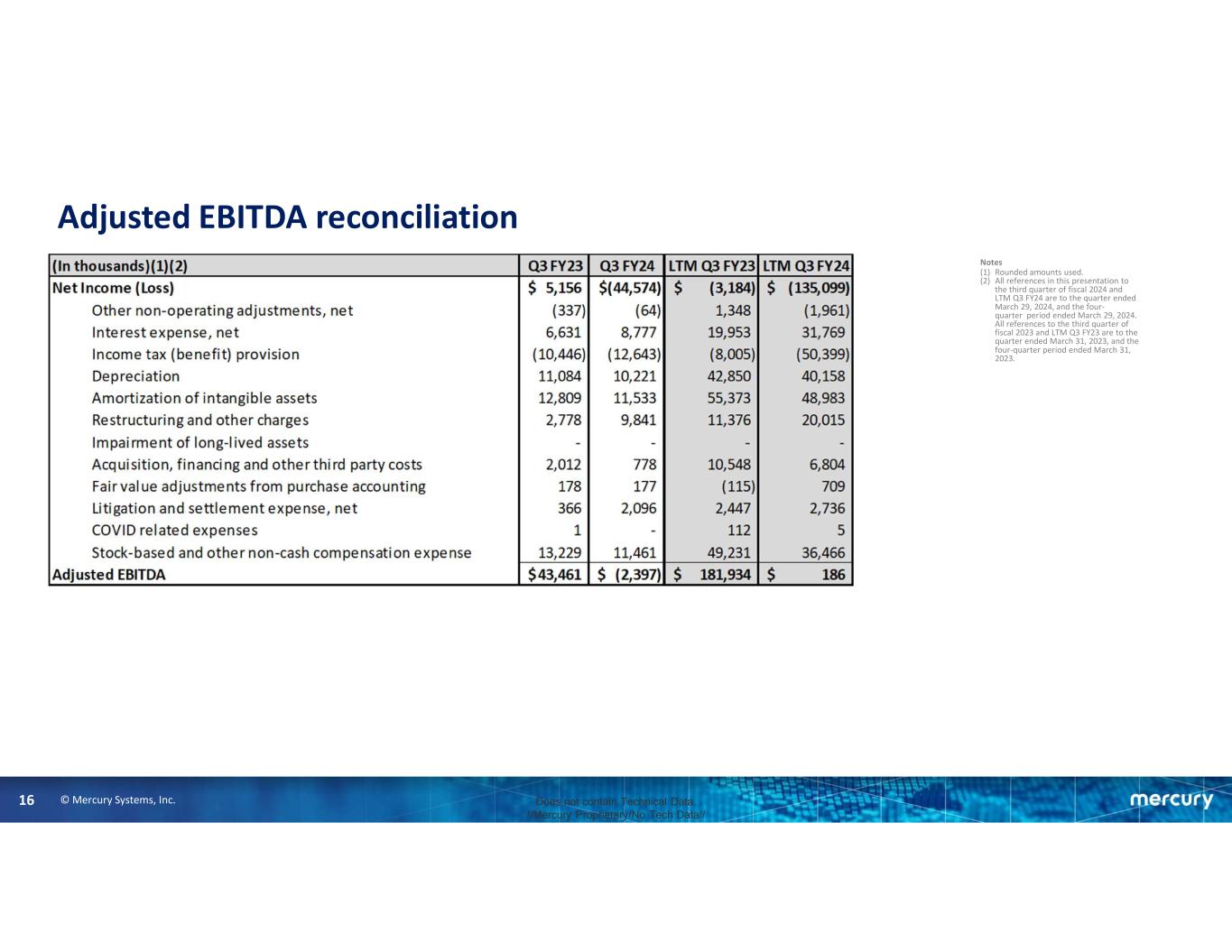
© Mercury Systems, Inc.16 Does not contain Technical Data. //Mercury Proprietary/No Tech Data// Adjusted EBITDA reconciliation Notes (1) Rounded amounts used. (2) All references in this presentation to the third quarter of fiscal 2024 and LTM Q3 FY24 are to the quarter ended March 29, 2024, and the four- quarter period ended March 29, 2024. All references to the third quarter of fiscal 2023 and LTM Q3 FY23 are to the quarter ended March 31, 2023, and the four-quarter period ended March 31, 2023.
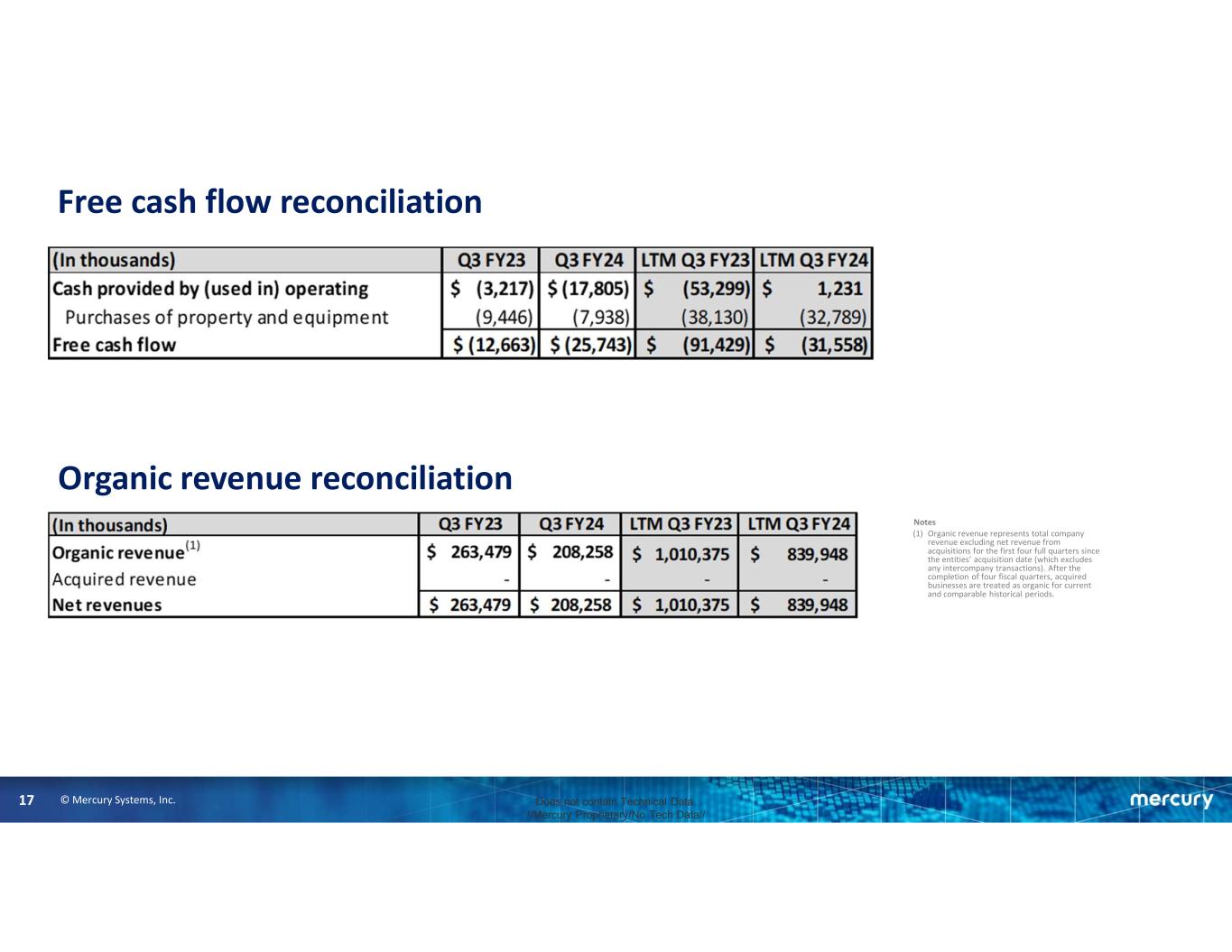
© Mercury Systems, Inc.17 Does not contain Technical Data. //Mercury Proprietary/No Tech Data// Free cash flow reconciliation Organic revenue reconciliation Notes (1) Organic revenue represents total company revenue excluding net revenue from acquisitions for the first four full quarters since the entities’ acquisition date (which excludes any intercompany transactions). After the completion of four fiscal quarters, acquired businesses are treated as organic for current and comparable historical periods.
















